
|
Tours Description
Tehran, sometimes spelled Teheran, is the capital of Iran and Tehran Province. it is Iran's largest urban area and city, one of the largest cities in Western Asia, and is the world's 19th largest city. In the 20th century, Tehran was subject to mass-migration of people from all around Iran.[4] The city is home to many historic mosques, churches, synagogues and Zoroastrian fire temples. Contemporary Tehran is a modern city featuring many structures, of which the Azadi (Freedom) Tower and the Milad Tower have come to be symbols of Tehran itself.
Archeological Museum , is a must see in Tehran. Collection includes: pottery, ceramics, stone figures and carvings from 5th & 4th millennium BC. Four tablets inscribed in cuneiform, Darius I inscription, carved staircase, tiles from Apadana Palace, and salt man are some of the highlights.
Carpet Museum, founded in 1976, exhibits a variety of Persian carpets from all over Iran, dating from 18th century to present. The museum was designed by the last Queen of Iran, Farah Diba Pahlavi.
National Jewels Museum, The treasury of Iranian national-royal-jewels accommodates the world`s most precious jewelry collection. The treasury has an interesting history, going back centuries. The decorations of the building include brickworks of the exterior.
Glassware and Ceramic Museum, The premises that have been turned into museum where glass and clay works are on display were built about 90 years ago and is a combination of the traditional Iranian style and the European architecture of the 19th century.
The collection of glass and clay works that are on display at the museum is among the rare collection in Iran it comprise clay pots dating back the 4th millennium B.C. up to the present time as well as glass works from 1rst millennium B.C. up to the contemporary era .European glass works belonging to the 18th and 19th centuries are also part of the collection.
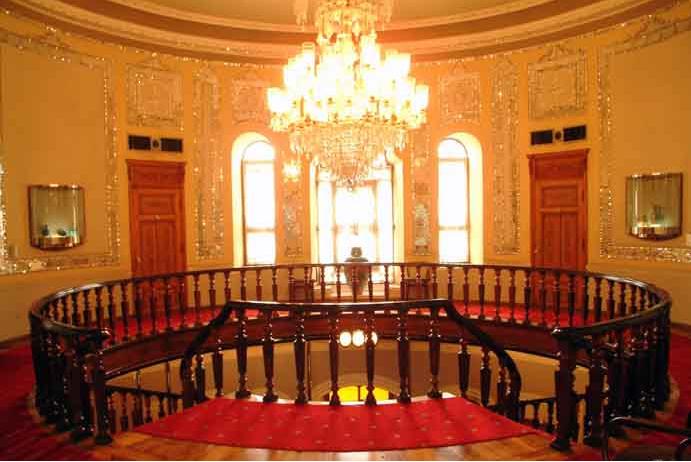
Isfahan, the legendary city which never fails to enchant its visitors, is the pearl of traditional Islamic archeology. This city is revived by the works of contemporary artists. Isfahan prides itself in having fascinating historical garden palaces. Legend has it that the city was founded at the time of tahmoures or Keykavous and because of its glories has been entitled “Half the World”.
The history of the city dates back to 2700 years ago. It was the capital of Iran in a number of the post-Islamic periods. The Naghsh-e Jahan Square in Isfahan is one of the biggest city squares in the world and an outstanding example of Iranian and Islamic architecture. It has been designated by UNESCO as a World Heritage Site. Today Isfahan, the third largest city in Iran, produces fine carpets, textiles, steel, and handicrafts. Historical sites in Isfahan are old squares, Palaces, Mosques, caravanserais, Bazaars, Bridges, Churches and cathedrals.
Sio se pol (33 bridges), one of the eleven bridges of Isfahanhighly ranked as being one of the most famous examples of Safavidbridge design. It consists of two rows of 33 arches. There is a larger base plank at the start of the bridge where the Zayandeh River flows under it, supporting a tea house.
Chehelsotun (40 pillars), an enchanting pavilion in the middle of a park at the far end of a long pool, built by Shah Abbas II to be used for his entertainment and receptions, The name, meaning "Forty Columns" in Persian, was inspired by the twenty slender wooden columns supporting the entrance pavilion, which, when reflected in the waters of the fountain, are said to appear to be forty.
Hasht Behest (8 paradises), dates back to the time of Shah Suleiman and is located in the middle of the HashtBeheshtGarden. The palace was the king's residence. A two story palace, with several rooms and cubicles.It’s beautiful exterior is decorated with bricks and tiles. The palace's surroundings have been changed into a public park.
Naghsh e Jahan, an important historical site and one of UNESCO's World Heritage Sites and the second biggest square in the world. It is 160 meters wide by 508 meters long, an area of 89,600 m2. The square is surrounded by buildings from the Safavid era.
Ali Qapu Palace, Agrand palace in Isfahan was built by decree of Shah Abbas the Great in the early seventeenth century. It was here that the great monarch used to entertain noble visitors, and foreign ambassadors. Shah Abbas, here for the first time celebrated the Now - ruz /New Year's Day/.
Kashan can be accounted as one of the archaic cities of Iran. Archeological discoveries in the Siyalk Hillocks which lie 4 km west of Kashan reveal that this region was one of the primary centers of civilization in the pre-historic ages. The said hillock flourished during the Sassanid and Safavid periods, and was the capital during the reign of Shah Abbas Safavid II. Kashan suffered severe damage during the Saljuqi and Mongol eras. This city and its respective villages were ruined due to earthquakes in the years 1192 AH. and 1260 AH. The city of Kashan has special features in regards architecture, historical and religious sites.
Vank Cathedral, of the first churches to be established in the city's Jolfa district by Armenian immigrants settled by Shah Abbas I after the Ottoman War of 1603-1605.
Jamee Mosque, A grand, congregational mosque. The mosque is the result of continual construction, reconstruction, additions and renovations on the site from around 771 to the end of the 20th century.
Abyaneh Village, is a famous historic Iranian village near the city of Kashan in Isfahan Province that is Characterized by a peculari reddish hue, the village is one of the oldest in Iran, attracting numerous native and foreign tourists year-round, especially during traditional feasts and ceremonies.
Fin garden, Historical Persian garden. It contains Kashan's Fin Bath, where Amir Kabir, the Qajarid chancellor, was murdered by an assassin sent by King Nasereddin Shah in 1852.
The Boroujerdiha House (Khāné-ye Borūjerdīhā), is a historic and fantastic house built in 1857, by architect Ustad Ali Maryam, for the bride of Haji Mehdi Borujerdui, a wealthy merchant. The bride came from the affluent Tabatabaei family, for whom Ustad Ali had built the Tabatabaei House some years earlier. It consists of a rectangular beautiful courtyard, delightful wall paintings by the royal painter Kamal-ol-molk, and three highwind towers which help cool the house to unusually cool temperatures.
The Tabatabaeis' House (Khaneh Tabatabaei-ha), is a historic house built in the 1840s for the affluent Tabatabaeifamily.It consists of a four beautiful courtyards, delightful wall paintings with elegant stained glass windows, and all the other classic signatures of Traditional Persian residential architecture such as biruni and andaruni.
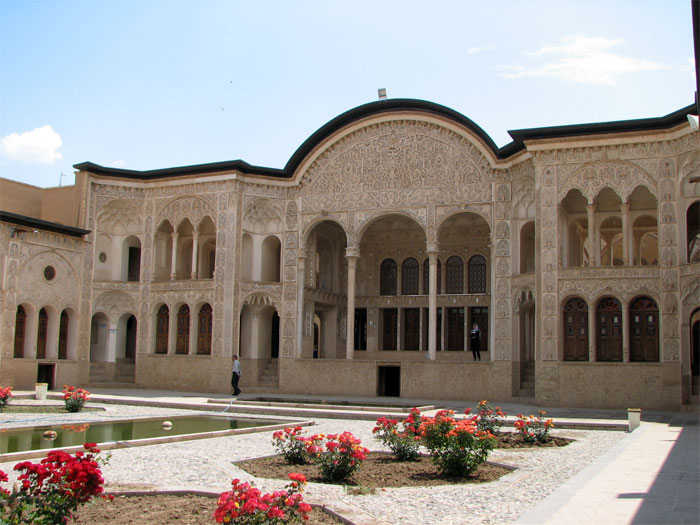
The holy city of Mashhad is the capital city of Khorasan Razavi province and is situated in the northeast of Iran. Mashhad is the second largest metropolis of Iran and the largest holy city in the world. In Farsi, khor means sun and san means place; together it means the place where the sun rises. Khorasan Razavi earned its name because of its capital Mashhad, in which Imam Reza a direct descendent of the Prophet Mohammad was buried. The city was founded around 823 AD, and its name derives from mashhad-e-reza, "place of martyrdom". It is a reference to the death of Imam Reza, the Eighth Imam of Shi'ite Islam, who is believed by members of the Shi'ia sect to have been poisoned there upon orders of Caliph Al Ma'mun. Also there is grave of Harun al-Rashid. Before his death the place was a small village by the name of Sanabad, which was in the country of Tus. Then a shrine was built there to commemorate the Imam, and gradually the town grew around it.
Among the first major buildings was a mausoleum built by Sultan Mahmood Ghaznavi. It was not a big city until Mongol raid which result in destroying of most of big cities of the Greater Khorasan but Mashhad wasn't destroyed. During Shahrokh era it becomes of the main cities of Timurid dynasty and his wife, Goharshad, funded the construction of an outstanding mosques beside the shrine. This mosque remains safe until now and its size show that Mashhad has been great and rich city during 15th century. Shah Ismail conquered Mashhad after death of Husayn Bayqarah and decline of Timurid dynasty. But Mashhad was captured by Uzbeks during kingdom of Shah Abbas I and after a long and severe struggle, Shah Abbas regained Mashhad, and defeated the Uzbeks in a great battle near Herat in 1597, driving them beyond the Oxus River. Shah Abbas I wanted to encourage Iranians to go to Mashhad for pilgrimage more than before. Therefor he went from Isfahan to Mashhad by walk. During Safavid era Mashhad gained more religious position and became the most important city of the Greater Khorasan and several Madrasah and buildings were built beside shrine of Imam Reza.
Besides its religious significance, Mashhad has played an important political role as well. It saw its greatest glory under Nadir Shah, ruler of Iran from 1736 to 1747 and great benefactor of the Imam Reza shrine, who made the city his capital. It remained capital of Afsharid dynasty until Agha Mohammad Khan Qajar conquered Khorasan in 1796.
The population of Mashhad is approximately 2.5 million and it covers a total area of more than 200 square kilometers. Annually, Mashhad and its surrounding countryside have over 20 million pilgrims and tourists from around Iran and the world. Thus, the province of Khorasan is a major economic, social, and cultural center of the country. In the past, Khorasan was a crossroad for the Silk Road and presently, all major air, rail, and roadways connect Mashhad to the rest of the nation as well as the world.
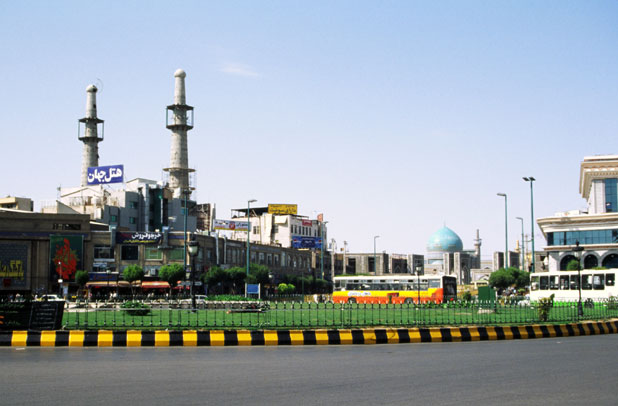
Imam Reza Holly Shrine, is the center of activity in Mashhad. Today the holy shrine and its museum hold one of the most extensive cultural and artistic treasuries of Iran, in particular manuscript books and paintings. Several important theological schools are associated with the shrine of the Eighth Imam.
As a city of great religious significance, it is also a place of pilgrimage. It is said that the rich go to Mecca but the poor journey to Mashhad. It is thought that over 20 million Muslims a year make the pilgrimage to Mashhad.
In 1912, the sanctuary of the Imam Reza was bombed by the Russian forces, causing widespread and persisting resentment in the Shiite Muslim world.
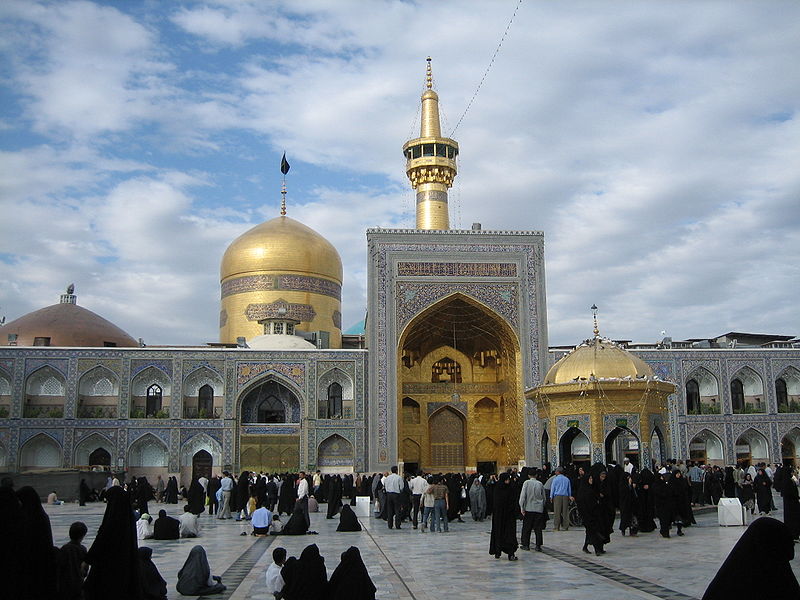
Nadir Shah Afshar's Tomb, is located in a beautiful garden in the heart of Mashhad. Nadir Shah Afshar's statue riding a horse and holding an axe in hand can be seen on the top of the tomb. There is a museum inside the tomb containing about 130 weapons, helmets and armors.Nadir Shah Afshar (born. 1688 A.D.) ascended the throne in 1148 A.H./ 1735 A.D., with his capital at Mashhad. He was killed in 1160 A.H./1747 A.D., in Quchan, in the Khorasan province.
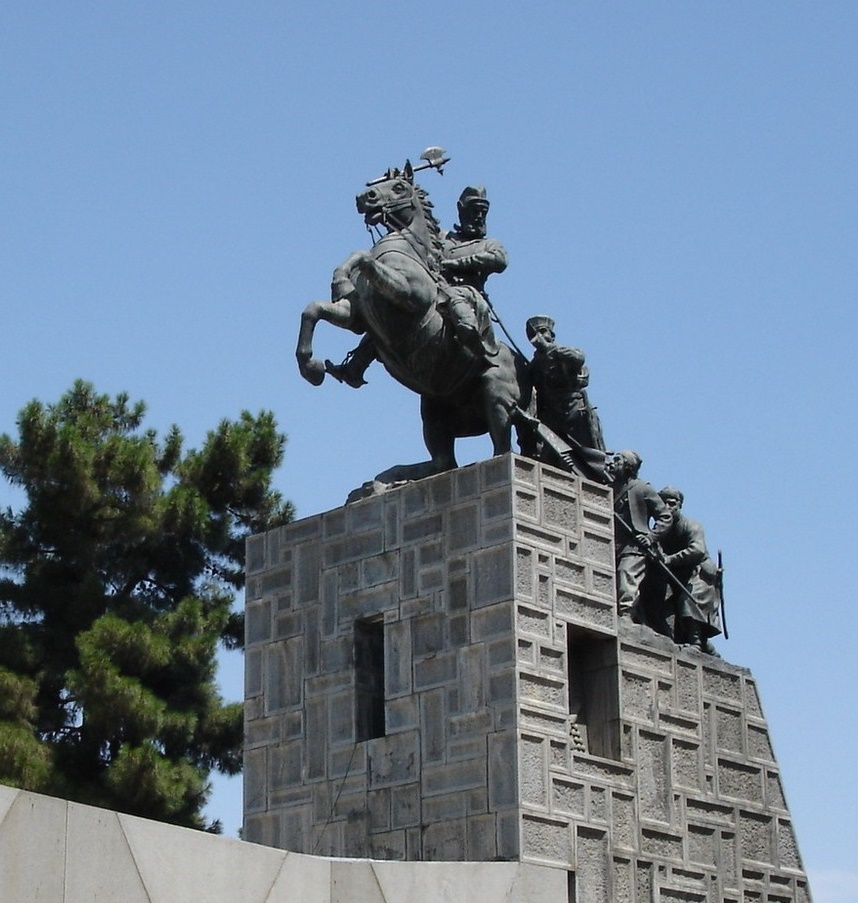
Ferdowsi Tomb, can be accounted for a place of ‘worship’ so to be called by the lovers of Farsi Literature. This renowned historical site has brought fame for the city of Toos. The construction of this tomb began in the year 1928 and work came to an end in 1934. In the year 1964 a few changes were made in the structure. The internal walls of the tomb are adorned with sculptures depicting scenes from the ‘Shahnameh’.Each side wall of the building is approximately 30 m. x 30 m. and each of the four sides have stairways lead up to it. The lenght of each side of the main buildings foundation is about 16 m., worked with marble it is adorned by verses from the Shahnameh in the Nasta'liq script. Above the southern stone, a symbol of the Ahuramazda embossment, a replica from Achaemenian buildings is in sight. At the vicinity of the tomb of this great Iranian poet, is the resting place of a contemporary poet Mehdi Akhvan Saless.
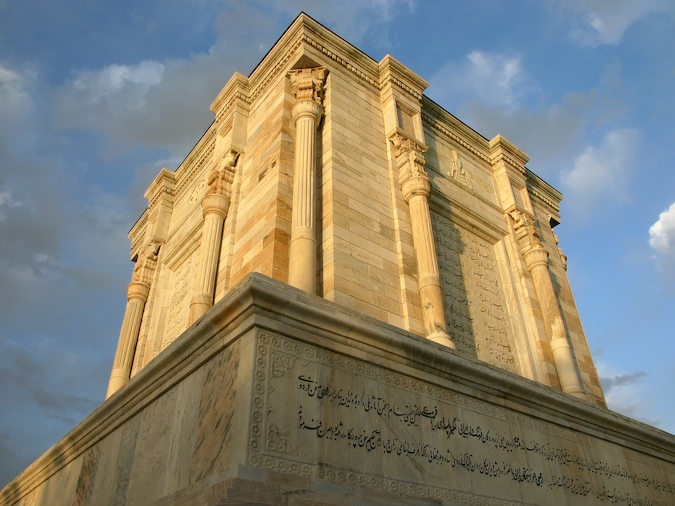
Harunieh Dome. This 14th century large brick building, about 1 km south of Ferdosi tomb is the only remain from the ancient Toos.
There are different theories about this structure, some say 1) it was the Harun's prison, the killer of Imam Reza, 2) the Mosque of Toos, 3) Tomb and mausoleum of Ghazali. Recent investigations say that it is a tomb or a mausoleum built adjacent to another religious structure on top of the remains of ancient structure, 13th and 14th AD.
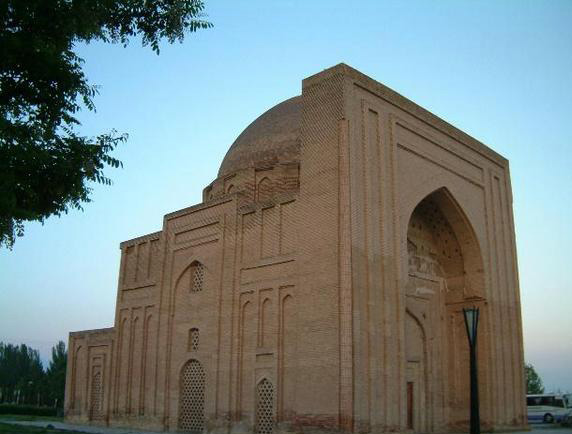
Shiraz is the capital of Fars province and the fifth most populated city in Iran. Shiraz is known as the city of poets, wine and flowers. It is also considered by many Iranians to be the city of gardens, due to the many gardens and fruit trees that can be seen in the city. Shiraz has had major Jewish and Christian communities. The more popular attractions of Shirāz include first and foremost the tombs of Hafez, Saadi, and Khaju e Kermani., Atigh Jame' Mosque, which is one of the older mosques of Iran, followed by Vakil Mosque and Nasir al-Mulk mosque with their unique architecture.
Karim Khan Arg Complex, was built as part of a complex during the Zand dynasty and is named after Karim Khan, and served as his living quarters. In shape it resembles a medieval fortress.
Mausoleum of poet Hafez, An 8th-century Persian lyric poet. His collected works (Divan) are to be found in the homes of most Iranians, who learn his poems by heart and use them as proverbs and sayings to this day and have influenced post-Fourteenth Century Persian writing more than anything else has.Johann Wolfgang von Goethe a famous German poet says:Suddenly I came face to face with the celestial perfume of the East and invigorating breeze of Eternity that was being blown from the plains and the wastelands of Persia, and I came to know an extraordinary man whose personality completely fascinated me. He calls him "Saint Hafez" and "celestial Friend". Goethe was acquainted with Iranian Literature and time.
Mausoleum of poet Saadi, 7th century one of the major Persian poets of the medieval period. He isrecognized not only for the quality of his writing, but also for the depth of his social thoughts.
Eram Graden, A famous and beautiful garden, which has been praised for its beautiful flowers, refreshing air, tall cypresses (a stately, beautiful cypress tree there known as sarv-e naz has long been a major tourist attraction), fragrant myrtles, flowing way of the constructional work.
Bazaar-e-Vakil, the main bazaar of Shiraz from establish on 11th century(completed on 18th century), located in the historical center of the city which has beautiful courtyards, caravanserais, bath houses, and old shops which are deemed among the best places in Shiraz to buy all kinds of Persian rugs, spices, copper handicrafts and antiques.
Holly Shrine of Shah-e-Cheraq, A funerary monument and mosque in Shiraz.
Pasargad
Pasargadae, UNESCO World Heritage-designated: The tomb of Cyprus the great, also known as Cyrus II or Cyrus of Persia, the founder of the Persian Empire under the Achaemenid dynasty (559–529 BC). He was a righteous human being because at the time of victory, he was generous toward defeated people. Being a freeman, he won the heart of his people, permitting them to worship their gods. He was extraordinarily peerless in all over the world. Comparing Cyrus' manner with Semi's rulers, one feels great pleasure for the Persian liberality and generosity and truly regards the Persian as the instructor of human race).
Persepolis
Archaeological evidence shows that the earliest remains of Persepolis date from around 515 BC. The first scientific excavation at Persepolis was carried out by Ernst Herzfeld in 1934. Herzfeld believed the reasons behind the construction of Persepolis were the need for a majestic atmosphere, a symbol for their empire, and to celebrate special events, especially the “Nowruz”. The UNESCO declared the citadel of Persepolis a World Heritage Site in 1979. Persepolis is also one of the 80 treasures featured on Around the World in 80 Treasures.
Naghsh-e-Rostam , where you will see 4 tombs in the mountain of Darius I, Artaxerxes I, Xerxes I, and Darius II Eight stone carvings from Sassanians dynasty below the Achaemenians tombs showing conquests of kings; believed was created to celebrate the victory of Sassanians king, over the Romanian invader.
Naghsh-e-Rajab, a beautiful stone carved from Sassanians dynasty (224-651 A.D.), at your leisure in the morning.
|